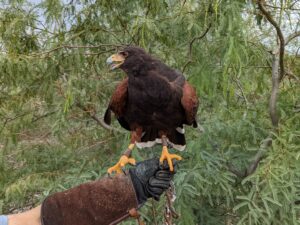Harris’s Hawk – Salsa
 Name: Salsa – Female
Name: Salsa – Female
Species: Harris’ Hawk
Liberty Arrival: June 3, 2008/Nestling
Injury/Condition: Trichomoniasis disease
Salsa was a nestling that was near fledging when she was brought to Liberty Wildlife after being found on the ground in Phoenix. Medical services staff discovered that Salsa had contracted Trichomoniasis or canker that was deeply embedded in the right side of her lower mouth and mandible. As Salsa’s treatment progressed, the tissue on the right side of her mouth sloughed off, leaving considerable scarring. This scarring reduced the size of her mouth opening, consequently limiting the size of food she could swallow and her ability to eat quickly. In the wild, these limitations would result in her starving to death because she could not consume sufficient food fast enough to survive the competition. The disease also caused her beak to be slightly malformed, hindering her ability to eat quickly.
Harris’ Hawk Facts
Also known as the “Wolves of the Sky”, Harris’s hawks can be found in the southwestern United States (Arizona, New Mexico, and Texas) through Central America and into the drier parts of South America. In Arizona, its range typically extends only as far north as Wickenburg. The Harris’ hawk is one of only two hawks known to hunt in a cooperative group manner (The Galapagos hawk is the other). It displays one of the most advanced group hunting tactics among birds.
Life span: The average life expectancy of the Harris’ hawk has been estimated to be up to 12 years in the wild and twice as long in captivity.
Prey: The majority of its prey consists of mammals such as cottontail rabbits, jackrabbits, rats, ground squirrels, gophers. Their diet is also supplemented by birds, primarily Gambel’s quail, and reptiles.
Babies/Nests: Nests of sticks and other materials are built in or on top of solid structures such as trees, saguaros, electric or telephone poles. The female usually lays 3 to 4 eggs and incubation lasts between 31 and 36 days. The young fledge in about 40 days.
Halcón de Harris – Salsa
Nombre: Salsa – Hembra
Especie: Halcón de Harris
Llegada a Liberty: 3 de Junio, 2009 / Pollita
Herida/Condición: Enfermedad Trichomoniasis
Salsa era una pollita cuando la trajeron a Liberty Wildlife después de que la encontraron en el piso en Phoenix. Personales médicos descubrieron que Salsa contrajo Trichomoniasis o canker que estaba encrestado profundamente en la parte baja de su boca y mandíbula. Cuando el tratamiento de Salsa progreso, el tejido de piel de su boca se desprendió dejándole cicatrices. Esta cicatrice redujo la habilidad de poder abrir su boca completamente, por lo cual limito el tamaño de la comida que podía tragar y su habilidad de poder comer rápido. En el estado salvaje estas limitaciones resultarían en que Salsa se muriera de hambre como no podría comer su comida suficientemente rápida para poder sobrevivir su competencia. Esta enfermedad también causa que su pico sea un poco malformado también limitando su habilidad de poder comer rápido.
Datos del Halcón de Harris
Descripción: También conocidas como los “lobos del cielo”, el Halcón de Harris puede ser encontrado en el sur oeste de los Estados Unidos (Arizona, New Mexico, y Texas) a través de Centroamérica y en las partes mas secas de Sudamérica. En Arizona su rango típicamente se extiende hasta el Norte en Wickerburg. El Halcón de Harris es uno de los dos tipos de halcones conocidos por cazar en grupo cooperativo.
Duración de vida: La esperanza de vida del Halcón de Harris fue estimado poder llegar hasta los 12 años en el estado salvaje y en cautiverio pueden sobrevivir has lo doble.
Presa: La mayoría de su presa consiste en mamíferos como los conejos de cola de algodón, liebres, ratas, ardillas, y tuzas. Su dieta también es suplementada por pájaros, como la codorniz de gambel, y reptiles.
Nidos: Sus nidos consisten en palos y otros materiales, son construidos a dentro o encima de estructuras firmes como los arboles, saguaros, o postes de electricidad o de teléfono.
Crías: La hembra pone 3 a 4 huevos y la incubación dura entre 31 y 36 días. Después de aproximadamente 40 días, los jóvenes se van del nido.


